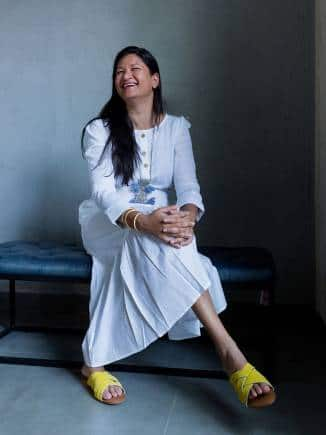



The Indian restaurant industry is abuzz with news that increasingly seems bad. Le15, Mumbai’s foremost café and patisserie, has shuttered its Colaba outpost for all operations. The rent rates in the city’s premium real estate stretch proved to be too immense for the glass-fronted café with a reputation of attracting SoBo’s influential names.
In a heartfelt note, owner and patissier Pooja Dhingra wrote, “I just couldn’t sustain the costs and overheads in a lockdown. The business wouldn’t survive. I knew what had to be done.”
 Eleven Madison Park.
Eleven Madison Park.The other news comes from New York, Mecca of urban food and restaurant culture. Eleven Madison Park rated the world’s best restaurants several-times-over, may just not reopen after the lockdown is lifted. Chef-owner Daniel Humm has said, “It will take millions of dollars to reopen. You have to bring back staff. I work with fancy equipment in a big space. I want to continue to cook with the most beautiful and precious ingredients in a creative way, but at the same time, it needs to make sense.”
 Daniel Humm, Eleven Madison Park.
Daniel Humm, Eleven Madison Park.The second bit of news has been received with a lot more trepidation across the world, including India, where the best chefs are struggling to fathom ways to reopen their restaurants, keeping in mind rigid but much-needed norms on hygiene, sanitisation and social distancing, while reinventing the dining experience.
 Riyaaz Amlani.
Riyaaz Amlani.National Restaurant Association of India (NRAI) estimates that the industry employs roughly 7.3 million people; in 2018-19, it contributed Rs 18,000 crore in taxes. Roughly, the association estimates that almost 40 percent of the restaurants may never open after the lockdown. “We have a high failure rate. Yet, we are perceived as a glamorous industry with huge profit margins. In reality, there are just huge debts and very thin margins,” says Zorawar Kalra, founder of Massive Restaurants (Farzi Café and Masala Library by Jiggs Kalra).
 Ankit Mehrotra, Dineout.
Ankit Mehrotra, Dineout.Chef Manu Chandra, the man credited with super-successful F&B brands such as Monkey Café and Olive Bar & Restaurant, estimates that the $50 billion industry is compromised by at least 15-20 percent and has high debts. “Given that we work on deferred payment, there is no liquidity.”
Is ‘contactless dining’ the answer?Stepping into this grim arena are food aggregators such as Zomato and Dineout, promoting what they call “contactless dining”. Dineout has presented a white paper on guidelines for restaurants post-COVID, released by Additional Director General of the Ministry of Tourism, Rupinder Brar this week.
“Contactless Dining removes nonessential human interaction and replaces it with seamless technology. In the post-COVID world, diners will be sceptical about stepping out and wary about touching unsanitised surfaces. There is a multitude of touchpoints that a restaurant can modify and facilitate with the introduction of technology. These can be simple actions like booking a table, pre-ordering meals, takeaway, digital ordering, digital payment, etc,” says co-founder and CEO Ankit Mehrotra.
Among their recommendation to make dining contactless: digital menus; steam sterilisers on tables to sanitise cutlery, which should not be left laid out on tables; digital wallet payments; pre-booking tables by customers, who will receive the menu on their phone and can pre-order before they arrive; and a live stream of behind-the-scenes from the kitchen to the diner’s phone through a link, so that they can ensure their food is being cooked in hospital-like hygienic conditions.
“The cost of installing this technology is about Rs 50,000 annually,” says Mehrotra. “There is no investment in hardware and a restaurateur spends only on the gateway cost and a digital camera to live-stream from the kitchen.”
 Kapil Chopra.
Kapil Chopra.Gaurav Gupta, Founder and COO, Zomato, pitches contactless dining as a means to “eliminate the use of high-touch elements. Imagine a full-stack tech-enabled dining experience, but with the least risk to health and safety. “The new ways of working will make some tasks redundant, and yet pave the way for more value-added tasks. Restaurants and the wait staff will be able to focus on what they do best — preparing great food and catering to the personalised needs of users.”
Restaurateurs are sceptical“I hate that word,” bursts out Zorawar Kalra.
While Dineout’s whitepaper offers a macro-view of the issues restaurants are likely to face, Rachel Goenka, CEO and Founder, The Chocolate Spoon Company, contends that it does not grasp ground realities or the nuances of how the industry works. “It falls short when it comes to the substance behind their thought process. They have no clue what safe and approved sanitisation chemicals are required to ensure kitchen hygiene, utensil hygiene or cutlery hygiene, or the frequency of cleaning required. We have already put SOPs that are likely to be more stringent than what the regulators propose, in place. Biometrics is being discouraged and we are reverting to manual attendance. The staff will not be allowed to wear uniforms outside the restaurants.”
 Chef Rahul Akerkar.
Chef Rahul Akerkar.Besides, as Chef Rahul Akerkar, the man behind restaurants such as Indigo and now Qualia contends, why would they pay a huge amount to buy QR codes or digital payment gateways and software from aggregators, when they can find solutions in-house in a fraction of the cost? “Why would I share details of my guests, which are private, with an aggregator? I don’t need a third-party platform to enhance my dining experience. Besides, I have to protect my brand value.”
Restaurateurs contend that contactless dining would be an experience so impersonal that it will resemble “the QSR format. People might as well drive into a fast food joint, place the order and leave with it,” says the gobsmacked Akerkar, who is still trying to make sense of the situation.
Kalra believes that some amount of rigid disciplining will be crucial. “People will continue to be plagued by an intense fear psychosis for six to eight months. And we have to instil confidence in them. We plan to sanitise each table with UV sanitisers, use disposable crockery, maybe even use frozen chicken to decrease contamination, though I hate that idea.”
 Gauri Devidayal.
Gauri Devidayal.While some restaurateurs like Devidayal flirt with the idea of using their staff for home deliveries (a parallel stream that is helping restaurateurs mitigate costs), others like Akerkar believe that aggregators will continue to be important, given that they have the delivery infrastructure already established.
Chopra, in sharp contrast, predicts the growth of takeaway as a segment. “In Delhi, a delivery boy who had COVID forced 72 people into quarantine, so people are unlikely to trust them. Restaurants will have to come up with their fleets to control the experience and ensure better monitoring unless delivery aggregators can monitor their delivery boys and provide them with proper accommodation.”
Is contactless dining even possible?That restaurants will have to reinvent the way they function is a given. Arja Shridhar, partner at Indianapoli Hospitality (Gustoso and Rue Du Liban) contends that reservations will have to be taken in advance, besides restricting seating to four guests per table. “These are just temporary measure, till a cure is found or a vaccine is invented.”
Most restaurateurs believe what aggregators are pushing is misleading as it implies that all human contact points are removed. “There are touchpoints in the workplace, in the grocery store, etc. The white paper ignores the fact that hospitality is based not just on great food, but also great service. Servers interact with guests, make recommendations, chefs prepare food, bartenders mix drinks... You cannot remove the human element completely from a dining out experience,” Goenka points out the obvious.
Restaurateurs like Gauri Devidayal, NRAI Managing Committee Member and Partner, Food Matters India (The Table, Magazine St Kitchen) assert that the dining-in experience is made vibrant by close interaction between the staff and guests (from recommending dishes to which wine or spirit pairs well with which dish). “It isn’t like we did not have digital menus, but we didn’t use it because people like the touch-and-feel, they like interacting with chefs and asking for personal recommendations,” she says. “While technology will have to be adopted, we are not a McDonald. The relationship between the staff and the guest is one of trust and warmth and cannot be overlooked.”
 Zorawar Kalra.
Zorawar Kalra.What is being floated as contactless dining is just 10 percent of the entire restaurant experience. Kapil Chopra, chairman on the board of aggregator EazyDiner and founder of The Postcard Hotels & Resorts contends, “The experience comprises of many parts. While hot food may be safe, a lot of vegetables are used in condiments and salads and it’s important to see how they are processed. We have just seen that eight people have tested COVID positive in the Gurgaon wholesale market. We also know that in the US, one of the largest sources of COVID was in the meatpacking district of New York. A safe dining experience is also dependent on how chefs are cooking. Are the vegetables being cut and cooked in different areas, using a different pair of gloves? Are they sanitising the chopping boards for raw vegetables differently? Are they washing their hands every 30 minutes? These are nice guidelines to have on paper but the strict implementation of all this is very important.”
 Arja Shridhar.
Arja Shridhar.In the confusion that prevails, few are focusing on is the residential address of the restaurant staff and the chefs, and that’s because restaurateurs can do very little about it. “Normally, the employees stay together in clusters. For example, in Mahipalpur, Delhi, where almost 3,000 hospitality professionals are staying in close vicinity. The chances of the virus spreading amongst this community are high even if one of them tests positive.”
Besides, most can't avoid contact with the several touchpoints between the kitchen and the table. “The server is going to come into contact with the kitchen as well as the diners. What if the food got contaminated with a sneeze or something before it got picked up by the server?” asked Chopra.
Pertinent arguments to which the industry, grappling with an existential crisis, is still looking for answers. Chefs like Akerkar are not quite sure about the shape that the post-COVID restaurant will take. “There are a lot of questions and very few answers. What kind of experience would it be if the server is completely swaddled in layers to avoid infection?”
The big churnIn the huge restaurant churn, many are expected to fall by the wayside. “Many just won’t open up,” says Chef Vikas Seth, Culinary Director, Embassy Leisure (Sanchez and Sriracha restaurants in Bangalore). “We are grappling with high rentals and huge costs for the ingredients and other material. We are talking to vendors and landlords to manage their expectations according to market reality.”
 Chef Vikas Seth.
Chef Vikas Seth.Even when they do open, restaurants will have to deal with manpower shortages due to reverse migration. “But that could prove to be a blessing in disguise since we will all be working with slim staff,” says Chef Seth.
In a bid to save some, NRAI has launched the ‘Rise for Restaurants’ initiative. “Diners can support restaurants by buying virtual cash worth Rs 1000 at a flat 25 percent discount from an expansive list of restaurants across India and redeem it in the future against dining bills at the respective restaurants. At the time of purchase, customers only pay Rs 250. This amount will contribute to paying the wages and salaries of restaurant employees. The remaining is to be paid only when they dine at the restaurant,” says Devidayal.
The future looks interesting as restaurants try and clean up their processes and efficiency, even while they attempt to salvage as many jobs as possible.
Deepali Nandwani is a journalist who keeps a close watch on the world of luxury.Discover the latest Business News, Sensex, and Nifty updates. Obtain Personal Finance insights, tax queries, and expert opinions on Moneycontrol or download the Moneycontrol App to stay updated!
Find the best of Al News in one place, specially curated for you every weekend.
Stay on top of the latest tech trends and biggest startup news.